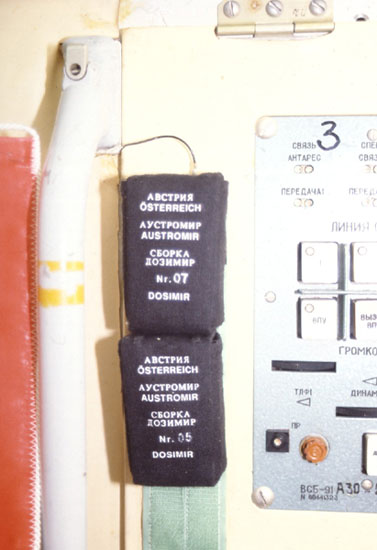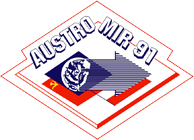In space, man and materials are exposed to particle radiation as well as electromagnetic ionizing radiation. The radiation affects on the material depends on the one hand, the total amount of energy absorbed, and on the other hand, the linear transfer of energy. This Linear Energy Transfer (LET) supplies information of how much energy per micrometer a particle delivers to a permeating material. Radiations with various LET also show various biological affects.
The values on earth are known. In space, an environment unfriendly to man, radiation is composed totally different and still unknown. Effective radiation protection can be a matter of life and death under such conditions.
Strong particle radiation can also damage the electronics on board the space vehicles. A basic rule for space-capable electronics is to place chips not too near of each other.
Objectives
A single device for both radiation types would simplify the measuring as well as save time, space and weight. A process to gather information about the LET spectrum with the help of thermoluminesence dosemeters (TDL) needed to be developed. This meant that with one such dosemeter type, being small and easy to use, all radiation types could be collected and quantitive conclusions about dose amounts of individual radiation types in mixed radition fields achieved.
New possibilities in the reactor and medicine dosimetry could be opened with such a new dosemeter type. The possibility of reaching quantitative conclusions about the composition of mixed radiation sources on earth is also tempting.
Functionality, Measuring principle
A special dosemeter material was developed and manufactured for the DOSIMIR experiment. It is litium fluoride-single crystals with dopants made from titanium and magnesium. If such a crystal was to be exposed with ionizing radiation, information would be saved as potential energy in the crystal’s net. This information is based on the dose of energy absorbed by the crystal. The crystals have to be heated up to about 300 °C for analysis. The saved energy will be released in the form of light and measured (with a photomultiplier). The light intensity, depending on the temperature, will be recorded whereby the related curve gives the extent of radiation absorbed by the dosemeter.
140 dosemeters in different variations where placed in a packet on board of the space station MIR. 23 nuclear track detectors were useed for comparing measurements. A dosimeter packet (DOSIMIR No. 5) was launched on 18 May 1991 and attached to a wall in the working area of the cosmonauts. The second packet (DOSIMIR No. 7) was brought by the Austrian cosmonaut in October 1991. At the end of the mission both packets were brought back to earth. Two similar packets (DOSIMIR No. 6 and 8) were used for comparing measurements.
Results
The results of the dosemeters from packet DOSIMIR No. 7 and the reference packet DOSIMIR No. 5 gave a very high exactness of the measuring values. This applied to the dosimeter of the same type as well as to the results of other dosimeter-materials. The absorbed dose from the Austrian dosemeter was 1.62 ± 0.02 mGy in tissue. The Russian results gave only slight differences. The results of the LiF-Dosemeters from the Russian Nuclear Institute gave similar results. In opposition to the results from the LiF-Dosemeters of TLD-200 (CaF2) show a slight gradient of dose towards the centre of the packet. This can be interpreted as the result of a small percentage of low energy bremsstrahlung in the radiation field in the space station MIR.

An analysis of the glow curves of the LiF-Dosemeters exposed on board the MIR show a significant increase of the high temperature region compared to the emission of CO-60 gamma irradiation. This increase conforms to a radiation field from a LET of about 7 KeV/micron. Based on the ICRP 26 such a field causes a quality factor of 1.9. If one calculates the equivalent dose during the russian-austrian flight with this quality factor, the personal equivalent dose of the Austrian cosmonauts is 3.11 mSv. This result is in good agreement with the results measured with a more complex active system during a French-Soviet mission in 1989.
This resulted in the usage of glow curves to quantify the LET dependency of single high temperature peaks. One achieves more exact results with this development. Even the phototransfer method was used and it shows that the yield of the phototransfer after a radiation with less LET is greater than the radiation in a field with high LET. The LET results measured with phototransfer are in overall good agreement with other results.
The results of the DOSIMIR experiment confirm that it is possible to enhance the thermoluminesence-dosimetry, and to gather information about the energy absorbed and also the information about the mean LET of the absorbed radiation. In the course of further analysis alternative methods like phototransfer, filter techniques and measurements of the TL-light emission spectra must be further developed. With these methods it could be possible to distinguish between various kinds of radiations and their different LET after exposure in a complex mixed radiation field. The development methods were already used in measuring radiation in aircraft, and it proved possible to determine the energy dose as well as the dose amounts of neutrons and heavily charged particles.
Practical application
Application ranges
- Space dosimetry of the radiation influence
- Radiation ecology, radiation checkup in companies
Application target
- Determination of the biological relevant equivalent dosis in mixed radiation fields
- Radiation security in the occupation of people and people groups
Direct interested institutions on the utilization of the experiment results
- Atom institute of the Austrian Universities, Vienna
- Institute for Biomedical Problems, Moscow
- Scientific centers and radiation security firms
Technical characteristics
DOSIMIR consisted of the following units
Dosimeter packet DOSIMIR
- Plastic container
- Cloth bag
- 140 Austrian thermo-luminescence dosimeter crystals
- 60 Soviet thermo-luminescence dosimeter crystals
- 23 track foils
| Mass: | 0.12 kg |
| Dimensions: | 75 mm x 50 mm x 30 mm |
On the actual experiments following Dosimeter packets was involved
Dosimeter packet No. 5
Liftoff on 18 May 1991 with the space transporter Sojuz TM-12
Return transport on 10 October 1991 with the landing machine of the space transporter Sojuz TM-12
Dosimeter packet No. 7
Liftoff on 2 October 1991 with the space transporter Sojus TM-13
Return transport on 10 October 1991, with the landing machine of the space transporter Sojuz TM-12
Dosimeter packet No. 6 & No. 8
Reference measurements on earth
Experimenters
Univ.-Prof. Dipl.-Ing. Dr. Norbert Vana (project manager)
Dipl.-Ing. Wolfgang Schoener
Univ.-Doz. Dipl.-Ing. Dr. Helmut Boeck
Dipl.-Ing. Rudolf Erlach
all: Atom institute of the Austrian Universities, Vienna
